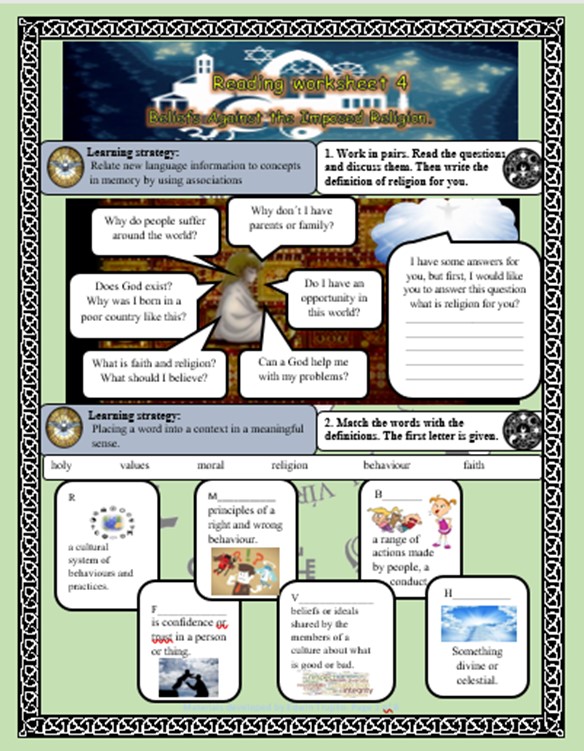5 de noviembre de 2018
Improving reading comprehension through designing CLIL materials
Edwin Armando Trujillo Amaya
This article approaches on the benefits of improving reading comprehension through designing contextualized materials. It also includes some useful sequences based on Content and Language Integrated Learning (CLIL hereafter) that foster the development of abilities for understanding texts, deducing and inferring information; and, generate processes such as critical thinking and problem solving.
Reading comprehension is the most common skill for asking and answering questions in education, and educators use it as a tool to evaluate students’ processes and verify learning. In Colombia this is a complex endeavour because most of students have many difficulties on it; that is why the National Ministry of Education has implemented the Bilingual Education program with the objective of having in 2019 students with an intermediate English Level (B1). Nonetheless, the education system is only centred on obtaining results without taking into account the processes and real learning.
In this regard, to achieve both (results and communication) reading plays an important role because through this skill, students can learn new words; improve the punctuation and grammatical structures in context enhancing oral and writing speech. To this respect, McCullough (1974), Harmer (2007), Gunderson (2009), and Weaver (2009) claimed that reading suggests models to re-think knowledge and provides topics that stimulate discussion, and imaginative forms which enhance memory processes. In other words, reading offers not only a possibility to obtain information from written documents, but also a way to enhance other processes such as interpretation, deduction, inference and comprehension, which are essential to make sense of written texts within the particular context in which they are read. In that sense, teachers should develop materials focused on reading to foster students’ comprehension.
Developing appropriate and pertinent materials is a must for EFL teachers who wish to improve their students’ reading comprehension. On the one hand, “Developing in-house materials makes it more feasible to address the demands of the institutional context and students’ profiles, and to achieve academic and language learning goals” (Núñez, 2010, p. 37). On the other hand, in the reading comprehension process, “the reader carries out a continuous, thoughtful dialogue with the information, ideas, opinions, or feelings expressed by the author. As he [/she] reads, the reader is constantly challenging, accepting, rejecting, weighing, and integrating the views expressed by the author” (Doake, 1974, p. 135). Thus, the effectiveness and success in improving reading comprehension is a task that depends on how useful and well elaborated materials are for students, and how teachers use texts, questioning, activities, and reading strategies to check the comprehension.
The design of contextualized materials like teacher-designed workshops, worksheets and booklets, among others is also vital to achieve language learning outcomes. These materials, according to Núñez, Téllez and Castellanos (2017), “are more likely to provide learners with rich, contextualized and comprehensible input to facilitate their language learning targets; raise awareness of their own learning process and assist their on-going development of a balanced set of skills and content” (p. 24). Nevertheless, the development of materials for reading should include some principles that Tomlinson (2003) established as essential rules for creating materials.
One possibility to develop materials for reading comprehension is to inform them with Second Language Acquisiton (SLA) principles. Correspondingly, they should include appealing, relevant and useful content that catches students’ attention, promoting the practice of the language in natural settings through diverse challenging activities that foster students’ confidence and participation (Tomlinson, 2012). In addition, materials should foster the application of learning and reading strategies to help students become more independent readers. Likewise, they should allow students to use reading techniques such as skimming and scanning to identify the topic, general ideas or specific information and to analyse the vocabulary to differentiate literal or implied meanings (Oxford, 1996; Brown, 2007).
Similarly, the selection of activities is the major point when teachers develop materials. In this respect, Núñez, Téllez, Castellanos and Ramos (2009) consider that it is crucial to “promote sensory stimulation, raise curiosity, supply clear participation opportunities, provide feedback and build valuable rewards for extrinsic motivation” (p. 23). Thus, CLIL is an approach that perfectly suits this goal. Several scholars as Dalton (2011), Pokrivcáková and Malá (2004) and Lee (2014) agree that CLIL provides students a space to interact in a foreign language, offering meaningful input, content that encourages communication, and learning activities that promote the use of the English language. When students read an authentic text, they approach it with communicative intentions by giving critical answers, reflecting on the information given and solving problems. CLIL fosters the practice and the use of the language in meaningful situations in which learners can increase their vocabulary, lexis and knowledge about the content. Finally, CLIL and reading materials should stablish a non-explicit sequence (pre-while-post) that demonstrates the advancement and learning process.
To sum up, fostering reading comprehension through materials focused on CLIL improves other communicative skills, help students to enhance their academic results, learn a foreign language and develop processes such as critical thinking and problem solving. Hence, the teacher needs to develop relevant, appropriate, pleasant and diverse learning activities which provide students with a variety of topics that motivate them to read and self-invest in their reading comprehension process.
References
Brown, H. D. (2007). Teaching by principles: an interactive approach to language pedagogy. (3rd ed.). San Francisco, CA: Pearson Longman.
Doake, D. B. (1974) Comprehension and teaching strategies. In E. J. Merrit (Ed.). New horizons in reading: Proceedings of the international reading association world congress on reading (pp. 13-19). Viena, Austria: 800 Barksdale Road.
Gunderson, L. (2009). ESL (ELL) Literacy instruction: a guidebook to theory and practice. (2nd ed.). New York, NY: Routledge.
Harmer, J. (2007). How to teach English: An introduction to the practice of English language teaching. Harlow, UK: Longman.
Lee. Che-Di (2014) Worksheet usage, reading achievement, classes’ lack of readiness,and science achievement: A cross-country comparison. International Journal of Education in Mathematics, Science and Technology, 2 (2), 96-106.
McCullough, E. C.M. (1974) Straws in the wind. In J. E, Merrit. (Ed). New horizons in reading: Proceedings of the international reading association world congress on reading (pp. 13-19). Viena, Austria: 800 Barksdale Road.
Ministerio de Educación Nacional (MEN). (2006). Serie Guías 22. Estándares básicos de competencias en lenguas extranjeras: inglés. Formar en lenguas extranjeras: ¡el reto! Lo que necesitamos saber y saber hacer. Bogotá, Colombia.
Núñez, A. (2010) The teaching of English within the theory-practice alternance model. In: Innovación y Competitividad Jornada de Investigación 2010. Dirección de Investigaciones y Estudios Empresariales Fundación Universitaria Empresarial de la Cámara de Comercio de Bogotá Uniempresarial.
Núñez, A., Téllez, M., & Castellanos, J. (2017). Teacher-developed materials in a master`s programme in education with emphasis on English didactics. Bogotá: Universidad Externado de Colombia.
Núñez, A., Téllez, M., Castellanos, J., & Ramos, B. (2009). A practical materials development guide for EFL pre-service, novice, and in-service teachers. Bogotá, Colombia: Departamento de Publicaciones Universidad Externado de Colombia.
Oxford, R. (1996). Language learning strategies around the world: Cross-cultural perspectives. Honolulu: University of Hawai I Press.
Pokrivcáková, S., & Malá. E. (2004). Developing Pluringuism in Slovakia: The CLIL Method, A starting point. PROFILE Issues in Teachers’ Professional Development, 5, 117-127.
Tomlinson, B. (2003) (ed.) Materials development for language teaching. London, UK: Continuum Press.
Tomlinson, B. (2012). Materials development for language learning and teaching. Language Teaching 45 (2), 143–179.
Weaver, C. (2009). Reading process: Brief edition of reading process and practice. Portsmouth, NH: Heinemann


